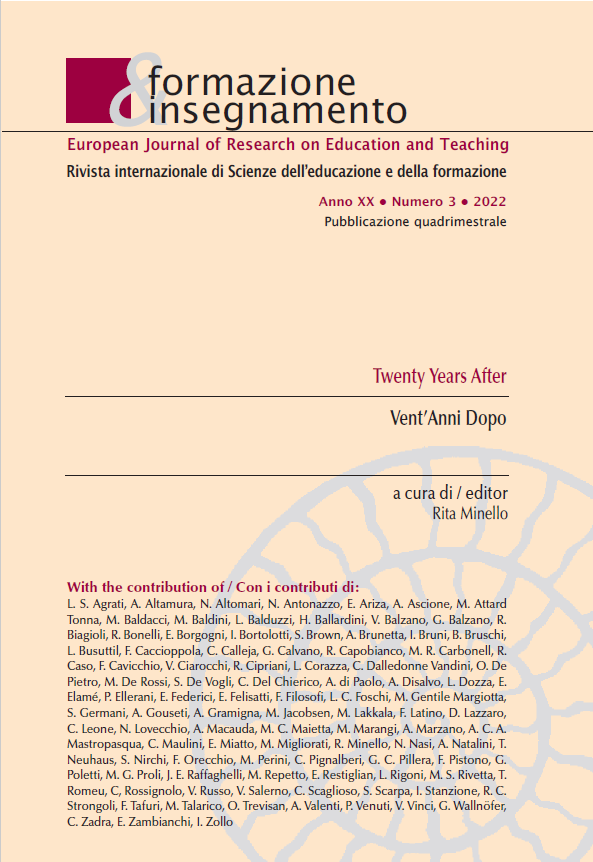La Cooperazione Universitaria per lo Sviluppo Sostenibile: L’Esempio dell’Università di Padova (Italia) e della Scuola Superiore Nazionale dei Lavori Pubblici (ENSTP) di Yaoundé (Camerun)
DOI:
https://doi.org/10.7346/-fei-XX-03-22_27Parole chiave:
Internazionalizzazione, Cooperazione internazionale, Camerun, Globalizzazione, Università, ItaliaAbstract
Gran parte dei lavori accademici sull’accelerazione che caratterizza il XXI secolo presenta la globalizzazione secondo una visione neoliberista del mondo, che incarna un’internazionalizzazione sempre più avanzata dell'attività economica. La globalizzazione incarna un’apertura delle frontiere, porta a una standardizzazione del tempo libero, degli stili di vita e dei consumi, oltre che produrre una cultura globalizzata e occidentalizzata. La nozione di globalizzazione mobilita gli istituti di istruzione superiore (IIS), attraverso la creazione di uno spazio educativo transnazionale, che fa parte delle dinamiche del libero scambio e dell’internazionalizzazione. Negli ultimi tre decenni (1990–2022), c’è stata una proliferazione di attività di internazionalizzazione negli istituti di istruzione superiore di tutti i continenti. In questo articolo, forniremo un’analisi critica delle attuali pratiche di cooperazione universitaria. Proporremo poi una definizione di cooperazione universitaria per lo sviluppo sostenibile. Infine, presenteremo un’esperienza di cooperazione universitaria per lo sviluppo sostenibile in corso tra l’Università di Padova (Italia) e la Scuola Superiore Nazionale dei Lavori Pubblici (ENSTP) di Yaoundé in Camerun.
Riferimenti bibliografici
Agbossou, I., Carel-Bergeon, S., & Caro, P. (2007). Les échanges européens Erasmus : accroître la mobilité des enseignants pour développer celle des étudiants. Céreq Bref, 246. Retrieved September 30, 2022, from https://www.cereq.fr/les-echanges-europeens-erasmus-accroitre-la-mobilite-des-enseignants-pour-developper-celle-des
AIU, Association Internationale des Universités. (2005). L’internationalisation de l’enseignement supérieur: Nouvelles orientations nouveaux défis – Rapport de l’enquête mondiale de 2005. Paris: Association Internationale des Universités.
AIU, Association Internationale des Universités. (2008). Internationalisation de l’enseignement supérieur : tendances mondiales, perspectives régionales, Rapport de la 3e enquête mondiale. Paris: Association Internationale des Universités.
Elamé, E. (2016). La ville durable interculturelle. L’Harmattan. Retrieved September 30, 2022, from http://digital.casalini.it/9782140025778
Elamé, E. (2017). L’agenda 21 scolaire de seconde génération : Transition vers une éducation durable. L’Harmattan. Retreived September 30, 2022, from http://digital.casalini.it/9782140025785
Elamé, E. (2022). L’urbanisme durable interculturel. In E. Elamé (Ed.), Urbanisme durable interculturel au service de la ville africaine du demain (pp. 9–49). ISTE.
Altbach, P. G., & Knight, J. (2007). Internationalization of higher education: Motivations and realities. Journal of Studies in International Education, 11(3–4), 290–305. https://doi.org/10.1177/1028315307303542
Bahoken, F. (2022). Représenter la mondialisation par des flux, le rôle de la distance cartographique perçue. Mappemonde, 133, 1–28. https://doi.org/10.4000/mappemonde.7558
Becker G., (1964). Human Capital: A Theoretical and Empirical Analysis, with Special Reference to Education. University of Illinois at Urbana-Champaign's Academy for Entrepreneurial Leadership Historical Research Reference in Entrepreneurship.
Bessieux-Ollier, C., Lacroix, M., & Walliser, E. (2006). Le capital humain: approche comptable versus approche managériale. Revue internationale sur le travail et la société, 4(2), 25–57. Retrieved September 30, 2022, from https://oraprdnt.uqtr.uquebec.ca/pls/public/docs/FWG/GSC/Publication/280/3/8542/1/100472/8/F_878128287_2006Vol4Num2pp25_57BessieuxLacroixWalliser.pdf
Bettahar, Y., & Allé, L. (2019). La mobilité internationale des personnels: enjeux et perspectives à travers l’exemple de l’Université de Lorraine. Journal of international Mobility, 7, 69–86. https://doi.org/10.3917/jim.007.0069
Breton, H. (2016). Mobilités transnationales et ingénierie des certifications : enjeux et limites des approches par compétence. Journal of International Mobility, 1(4), 25–42. https://doi.org/10.3917/jim.004.0025
Cosnefroy, L., De Ketele, J.-M., Hugonnier, B., Parmentier, P., Palomba, D., & Uvalic-Trumbic, S. (2020). L’internationalisation de l’enseignement supérieur: Le meilleur des mondes?. De Boeck Supérieur.
Handari, R., & Blumenthal, P. (Eds.). (2011). International students and global mobility in higher education: National trends and new directions. New York: Palgrave Macmillan.
Marquès, E. (1974). La comptabilité des ressources humaines. Hommes et Techniques.
OCDE. (1996). Mesurer le capital humain. Vers une comptabilité du savoir acquis. Éditions OCDE. https://doi.org/10.1787/9789264065499-fr
Pfeffer, J. (1995). Producing Sustainable Competitive Advantage through the effective Management of People. Academy of Management Executive, 9(1), 55–72. Retrieved September 30, 2022, from https://www.jstor.org/stable/4166208
Rodrik, D. (2022). Rééquilibrer la mondialisation. Esprit, 483(3), 37–47. https://doi.org/10.3917/espri.2203.0037
Tilak, J. B. G. (2011, 2012). Marchandisation de l’enseignement supérieur l’impact de l'Accord général sur le commerce des services (AGCS). In UNESCO-IIEP (Ed.), Principes de la planification de l'éducation, 95. Paris: UNESCO-IIEP. Retrieved September 30, 2022, from https://unesdoc.unesco.org/ark:/48223/pf0000214997_fre
##submission.downloads##
Pubblicato
Come citare
Fascicolo
Sezione
Licenza
Copyright (c) 2022 Esoh Elamé

TQuesto lavoro è fornito con la licenza Creative Commons Attribuzione 4.0 Internazionale.
Formazione & insegnamento è distribuita con la seguente licenza: Attribution 4.0 International (CC BY 4.0).
Per ulteriori dettagli, si rimanda alle Politiche di archiviazione e ai Termini di Copyright e Licenza.





